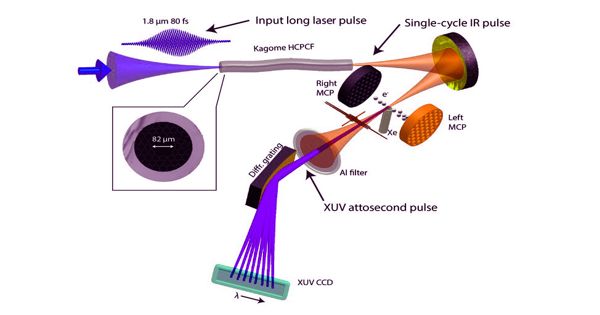New deception for infrared laser pulses in Laser technology
The word “laser” stands for “Light Amplification by Stimulated Emission of Radiation”. Ordinary solid-state lasers, as used in laser pointers, generate light in the visible range. For many applications, however, such as the detection of molecules, radiation in the mid-infrared range is needed. Now a new method has been presented that does not require large experimental setups; it can be easily miniaturized and is therefore particularly interesting for practical applications. Such infrared lasers are much more difficult to manufacture, especially if the laser radiation is required in the form of extremely short, intense pulses.
The new technology does not require large experimental setups; it can be easily miniaturized and is therefore particularly interesting for practical applications.
For a long time, scientists have been looking for simple methods to produce infrared laser pulses. For a long time, scientists have been looking for simple methods to produce such infrared laser pulses — at the TU Wien this has now been achieved, in cooperation with Harvard University. Laser Technology products calculate the distance by measuring the time of flight of very short pulses of infrared light.
The new technology does not require large experimental setups; it can be easily miniaturized and is therefore particularly interesting for practical applications. Any solid object will reflect back a certain percentage of the emitted light energy. This only needs to be a small percentage for our sensitive detector to pick it up. We measure the time it takes a laser pulse to travel to the target and back with precision, crystal-controlled time base. Knowing the constant speed of light, it is then easy to calculate the distance traveled. The new results have now been presented in the journal Nature Communications.
The frequency comb
Pulsed lasers are versatile tools for the scientist and engineer that have played an important role in the development of modern optical physics. “We generate laser light in the mid-infrared range with tailor-made quantum cascade lasers manufactured in the ultra-modern Nano-Center of TU Wien,” says Johannes Hillbrand from the Institute of Solid State Electronics at the TU Vienna, first author of the study. While in ordinary solid-state lasers the type of light emitted depends on the atoms in the material, in quantum cascade lasers tiny structures in the nanometer range are crucial. By designing these structures appropriately, the wavelength of the light can be precisely adjusted.
Light is like a pendulum
Pulsed lasers have proven to be especially helpful in the study of transient phenomena that occur in time intervals as short as femtoseconds, or as long as milliseconds or beyond. However, it is not only the frequencies emitted by such a quantum cascade laser that are decisive but also the phase with which the respective light waves oscillate. “You can compare this to two pendulums connected by a rubber band,” explains Johannes Hillbrand. “They can either swing back and forth, exactly in parallel, or opposite to each other, so that they either swing towards each other or away from each other. And these two vibration modes have slightly different frequencies.”
The light modulator
“In quantum cascade lasers, it has previously been difficult to switch back and forth between these two variants,” says Johannes Hillbrand. “However, we have built a tiny modulator into our quantum cascade laser, which the light waves pass by again and again.” An alternating electrical voltage is applied to this modulator. Depending on the frequency and strength of the voltage, different light oscillations can be excited in the laser.
“If you drive this modulator at exactly the right frequency, you can achieve that the different frequencies of our frequency comb all oscillate at exactly in sync,” says Benedikt Schwarz. “This makes it possible to combine these frequencies into short, intense laser pulses – more than 12 billion times per second.”















